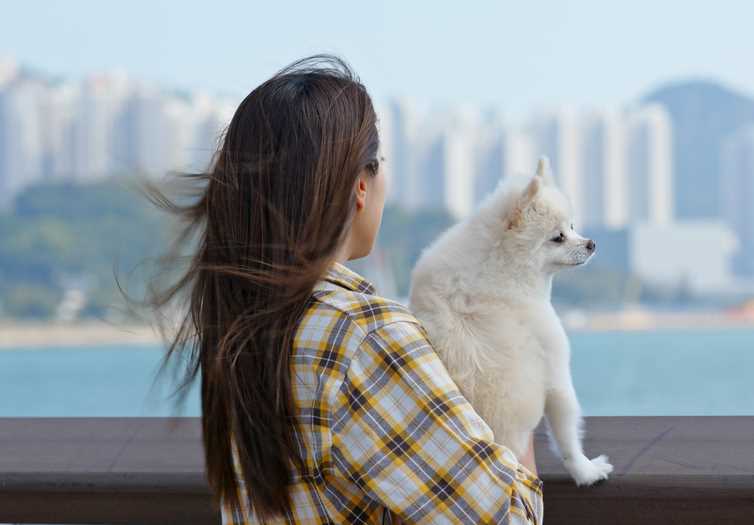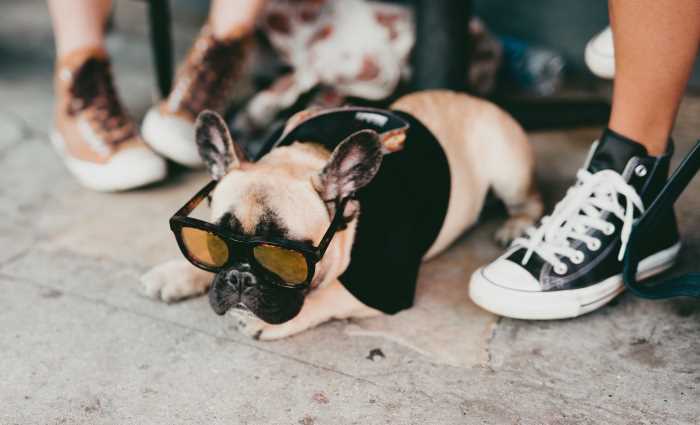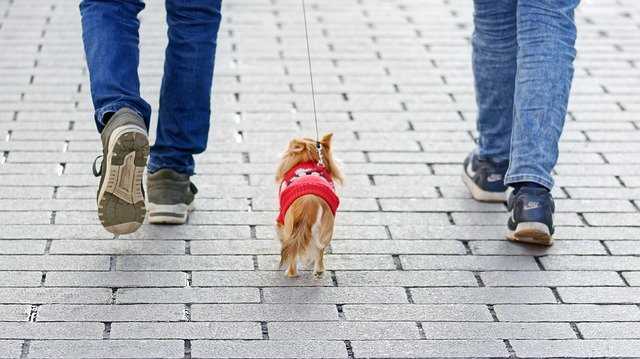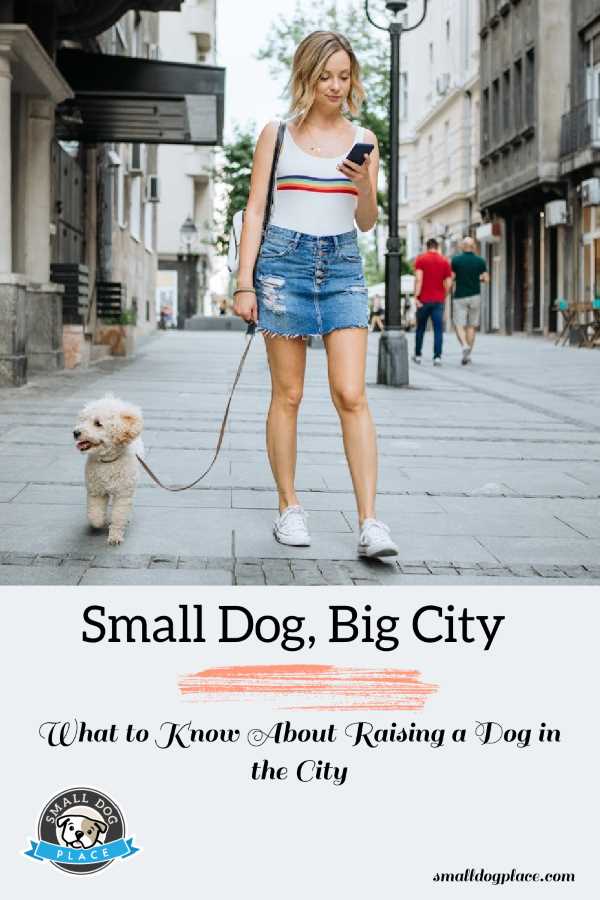- Small Dog Place Home
- Lifestyle
- Raising a Dog in the City
Small Dog, Big City: What to Know About Raising a Dog in the City
Raising a Dog in the City by Nicole McCray |Updated 04-12-2024
Some people think having a dog in the city is a bad idea, believing that they’re stuck in a tiny apartment all day. But that’s not the case at all. Most city dogs spend just as much time outdoors (maybe more) as rural dogs do.
That’s because people who live in urban areas walk everywhere, and they tend to bring their pups with them. From walks in the park to social outings and lunch at sidewalk cafes, small dogs are a common and welcome fixture of the downtown lifestyle.
 Raising a Dog in the City
Raising a Dog in the CityOf course, raising a dog in an urban environment isn’t quite the same as raising one in the suburbs. From potty training to exercise, and health care to socialization, here’s what city-dwelling pet parents need to know about raising a dog in a downtown area.
Raising a Dog in the City Table of Contents
Stay on Top of Vaccines and Parasite Control
Potty Training Your Small Dog in the Big City
Watch the Sidewalk in Front of You
Give Your Dog a Space of His Own
Raising a Dog in the City: Tips
Stay on Top of Vaccines and Parasite Control
Dog-friendly outdoor spaces in the city are usually shared by many pets and people. According to doctors at Bond Vet Animal Hospital in NYC, “It’s especially important to stay on top of vaccinations and parasite control when you have many animals sharing the same common space.”
Intestinal parasites, fleas, and ticks can all be transmitted from dog to dog. City dogs should be kept on monthly parasite prevention all year round to protect them from these issues.
Staying current on vaccinations also protects your dog from many transmittable illnesses, including rabies, kennel cough, and doggie flu. Keeping your dog’s vaccinations up to date also protects you if someone ever accuses your dog of biting them.
You don’t have to keep your proof of current vaccinations with you at all times, but your pup should have his rabies tag and an up-to-date ID tag on his collar whenever you leave your apartment.
Dog Proof Your Apartment
Before you bring home your new dog or puppy, take the time to dog-proof your apartment just like you would if you had a baby or toddler. Get down on a dog’s level, look for anything potentially hazardous and move it out of reach.
Chords, houseplants, cables, and remote controls can all be very tempting to a bored dog, and chewing on them could be dangerous. Of course, you’ll also want to make sure your valuable belongings are out of reach too.
Provide your new pooch with a safe play area and plenty of toys to keep him busy. Keep in mind that hard toys will make a lot of noise when your pup tosses them around, so plush toys are more neighbor-friendly.
Your puppy's toenails can be damaging to certain types of flooring. You might want to designate a specific play area with a mat or area rug to protect the floor and soften any noise your pup makes when playing.
Potty Training Your Small Dog in the Big City
Potty training a small dog in the city does come with some challenges, but dogs can adapt easily with proper training.
One of the biggest challenges is that dogs don’t naturally like to go to the bathroom on a hard surface, such as a concrete sidewalk. If you don’t have access to a green space, it may take your dog some time to adjust.
Another challenge is getting your dog down the elevator, through the lobby, and out to an appropriate potty area before he has an accident indoors. It’s even worse when everyone from the doorman to the neighbor wants to say hello and pet your pooch. This is especially challenging for a puppy.
But there are some strategies you can utilize that will be really helpful. First, follow a strict potty schedule and take your pup to the same potty spot every time you go out. Knowing when to expect a potty break and exactly where to go will help your pup learn to hold it until you get to the designated area.
You might also consider trying some in-house or balcony potty solutions for your pup, such as puppy pads or an indoor potty box. This can be especially helpful for young puppies, senior dogs, or whenever your trip to an appropriate potty place is very long or inconvenient.
Keeping your pup on a consistent feeding schedule is also key for potty training. It’s best to give him his meals about 20 minutes before you’re ready to head outside. That way, his body will get used to the schedule and he’ll be ready to go to the bathroom when you get out there.
“Curb” Your Dog
 When raising a dog in the city, it's important to "curb" him out of courtesy to other pedestrians.
When raising a dog in the city, it's important to "curb" him out of courtesy to other pedestrians.Curbing your dog is really about being considerate of others so that no one accidentally steps in your dog’s pee or poo. It simply means encouraging your dog to potty at the very edge of the sidewalk, or just off the sidewalk if there’s a safe place.
To teach this behavior, whenever he has to go, gently pull him to the curb. Dogs are creatures of habit, so they’ll figure out what they’re supposed to do pretty quickly, especially if you’re consistent about guiding them.
Of course, you’ll still need to bring along a bag for the poo. Leaving your dog’s waste on the sidewalk is unsanitary. It can also lead to the transmission of illness or parasites like hookworms and roundworms.
Watch the Sidewalk in Front of You

One of the most important things to think about when walking your dog in the city is watching the sidewalk in front of you. There can be all kinds of goodies on the sidewalk, from chicken bones to wrappers. It will all smell amazing to your pup, but you certainly don’t want him eating it.
To ensure that your pooch isn’t eating anything he shouldn’t, have him walk just a little bit in front of you so that you can keep an eye on him and the sidewalk.
Teach Your Dog Basic Commands
The experts at the ASPCA recommend that every city dog learns at least four basic obedience commands. They are “come,” “heel,” “leave-it,” and “sit/stay.”
It’s also a good idea to train your dog to stop, sit, and wait when you stop. If you’re at a busy intersection, you want your dog to stay in the sit position until you give him permission to start moving again.
More about Basic Dog Commands
Give Your Dog a Space of His Own
Dogs appreciate having their own cozy space to relax in, which is why many experts recommend crate training dogs and puppies. A crate or playpen with a comfy bed and a few favorite toys make a perfect doggy den.
If your dog loves to watch what’s going on around him, consider placing his crate near a window. That way he can occupy himself by watching all the interesting things going on outside.
Just be sure the sun won’t come in the window and cause him to overheat, especially if he will be confined to the space when you’re not home.
Or, if your dog prefers peace and quiet, set up his crate away from the windows. A cozy spot next to your bed could be a great spot. That way he’ll have the comfort of your familiar scent even when you’re not at home.
Consider Hiring a Dog Walker
If you’re out of the house all day for work, you might want to consider hiring a dog walker. A walker will stop by in the middle of the day to give your dog some much-needed exercise and companionship.
Then, if you walk him before and after work, and then right before bedtime, he should get plenty of exercise throughout the day.
If you’re not sure about a dog walker, doggie daycare is another fantastic option for dogs in the city. A couple of days a week at doggie daycare will give your pup some quality playtime and socialization while you’re at work.
Separation Anxiety in City Dogs
While city dogs aren’t any more prone to separation anxiety than rural dogs, it can be more of an issue for pet parents if it manifests as frantic barking and whining whenever you’re not home. In urban environments, a barking or whining dog is more likely to disturb the neighbors and create issues with building management.
You can try working with your vet and a trainer to help your dog overcome his anxiety. Running the television or playing music on low while you’re away may help if the anxiety is mild. Getting a second pet, such as another small dog or even a cat, may also be helpful.
But at the end of the day, taking a pup with separation anxiety to daycare while you’re at work is probably the best way to keep the peace until your pup’s anxiety issues are resolved.
Wrapping Things Up
If your pup is new to city life, it may take some time for him to get used to all the new sounds and activity. Try to introduce him to his new surroundings gradually so that he stays calm and safe.
The best way to ensure that everyone is happy- you, your pup, and your neighbors- is to ensure that your pup gets plenty of exercise and socialization. A bored pup is more likely to be noisy or destructive. Take advantage of the resources that are readily available for pets in the city, such as dog walkers, daycare, and doggie parks.
Having a dog in the city does require some special considerations, but there’s no reason your pup can’t thrive in an urban environment. Remember that many people and pets are sharing the same space, so proper training should be your top priority right from day one.
Author Bio (Raising a Dog in the City)
Nicole is a die-hard animal lover who has worked in pet care for years. She is a former vet technician, a dog mom to her two rescue pups, and she grew up living and working at her family's pet boarding facility.
Raising a Dog in the City: Pin for Future Reference
Did You Find, Raising a Dog in the City? Interesting?
About Janice (author and voice behind this site)
Janice Jones has lived with dogs and cats for most of her life and worked as a veterinary technician for over a decade. She has also been a small-breed dog breeder and rescue advocate and holds academic training in psychology, biology, nursing, and mental health counseling. Her work focuses on helping dog owners make informed, responsible decisions rooted in experience, education, and compassion.
When not writing, reading, or researching dog-related topics, she likes to spend time with her six Shih Tzu dogs, her husband, and her family, as well as knitting and crocheting. She is also the voice behind Miracle Shih Tzu and Smart-Knit-Crocheting
Does This Article Deserve Your Thumbs Up?
We always appreciate your support and encouragement. Your thumbs up means so much to us. Please like this article.
If you find this page or any page on Small Dog Place Helpful, or useful in anyway, I'd love it if you would click the small heart found on the bottom right of each page.
You can also share or bookmark this page -- just click on the:

Free Monthly Newsletter
Sign Up for Our Free Newsletter and get our Free Gift to You.
my E-book, The Top 10 Mistakes People Make When Choosing a Dog (and how to avoid them)







